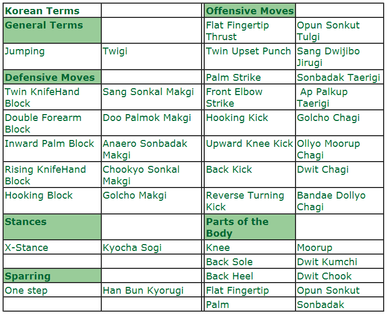Primary Taekwon-Do
Blue Stripe - 5th Kup
Practical
Combinations in Line Work – Taken from patterns
Combinations of traditional kicks
3 Step Sparring – Numbers 1 ,2, 3, 4 & 5.
One step sparring traditional basic
Free Sparring
Self defense release moves
Power test, techniques determined by examiner on the day
Sajo Jirugi 1, Sajo Jirugi 2, Sajo Makgi, Chon-Ji, Dan-Gun, Do-San & Yul Gok

Theory
Blue signifies the heaven towards which the plant matures into a towering tree as training in Tae Kwon-Do progresses
1.How many moves in Yul Gok? – 38
2.What is the meaning of Yul Gok? – Yul-Gok is the pseudonym of the great philosopher and scholar Yi l (1536-1584) nicknamed the ‘Confucius of Korea’. The 38 movements of this pattern refer to his birthplace on the 38 degree latitude and the diagram represents “scholar Gentleman & Samurai”.
3.What is the purpose of the 1st & 4th move of Pattern Yul Gok? – It is a focus and measure of the distance between yourself and a target area.
4.How do you perform Hocking block and what’s the Korean name? – Golcho makigi
5.How do you perform X stance and what’s its purpose & the Korean name? – Kyocha sogi – The ability to turn & pivot quickly in any direction
6.How do you perform twin knifehand block, what’s its purpose & the Korean name? – Sang Sonkal makgi – blocking 2 separate attacks at the same time with the knifehand.
7.What is the difference between grading sparring and competition sparring? – Grading is to show control, movement, blocks and a wide variety of techniques. Competition is using your best techniques.
8.How do you perform Double forearm block and what’s the Korean name? – Doo Palmok makgi
9.What is the Korean for Reverse Turning kick and what part of the foot is used? – Bandae Dollyo Chagi using Dwichook (Back Heel)
10.How do we get power into our techniques? – Speed & Acceleration, Breath Control (Kihap), Relaxation & Tension, Correct Technique, Body Mass
11.What is the difference between jumping and flying techniques? – Jumping is to gain Height and Flying is to gain Distance.
12.Name 6 blocks in English & Korean? – Najunde Bakat Palmok makgi, Kaunde An palmok makgi, Najunde Sonkal makgi, Chookyo makgi, Sang Palmok makgi, Sonkal Daebi makgi, Hechyo makgi, Dollymio makgi, Golcho makgi, Sang Sonkal makgi and Doo Palmok makgi.
13.What is the Korean for downward (axe) kick and what part of the foot is used? – Naeryo chagi using Dwichook (Back Heel)
14.What is the Korean for flat fingertip thurst? – Opun Sonkut Tulgi
15.What is the Korean for Walking stance & describe it? – Gunnon Sogi – 50/50 weight, Length is one & half shoulder widths and one shoulder width wide, front foot points forward & back foot point 25 degrees outward, front leg bent and back leg straight, primary leg is in front
16.What is the Korean for front elbow strike? – Ap Palkup Taerigi
17.What does the colour Blue signify? – Blue signifies the heaven towards which the plant matures into a towering tree as training in Taekwon-Do progresses.
18.Name 5 stances in English & Korean? – Gunnon (Walking), Annun (Sitting), Niunja(L stance), Narani (Parrallel), Charyot (Attention), Gojong (fixed), Moa (closed), Goburyo (bending), Kyocha ( “X” ) Sogi (Stance).
19.What is the Korean for free sparring? – Jayu Matsoki
20.What is the Korean for one step sparring? – Ilbo Matsogi
21.What is the Korean for Jumping, Flying, Strike, Thrust, punch, kick, block & stance? – Twigi, Twimyo, Taerigi, Tulgi, Jirugi, Chagi, Makgi & Sogi